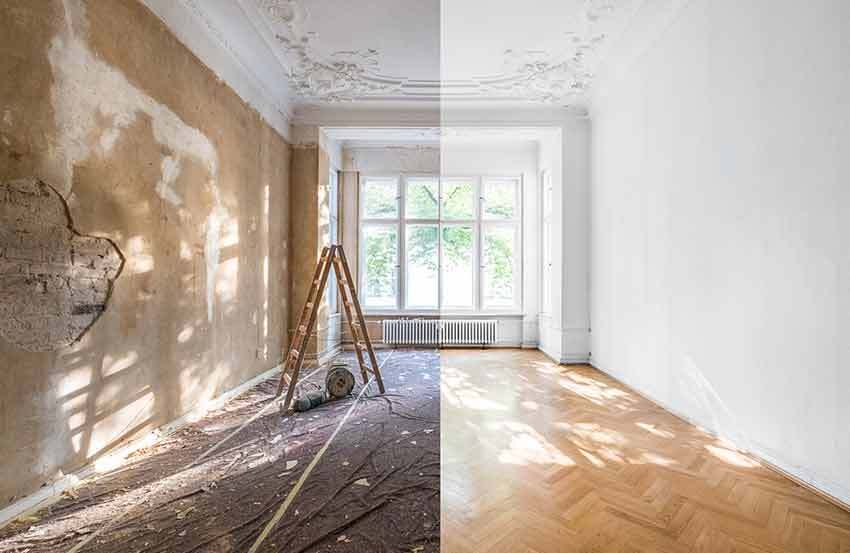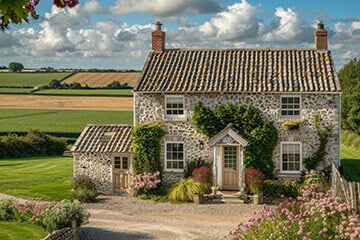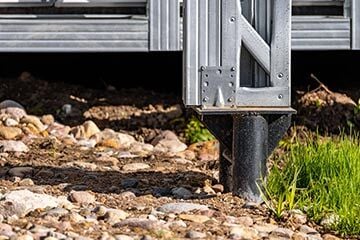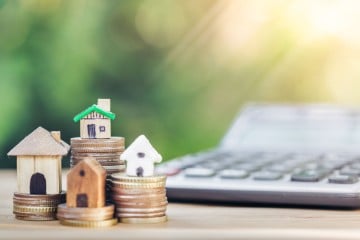Looking to upgrade your home while reducing your environmental impact?
We'll walk you through some eco-friendly renovation tips that save energy and cut down on waste - all while boosting your home's value.

Why sustainable home improvements matter
The upfront cost can put some people off, but sustainable home improvements tend to be worth the investment in the long term - both for your wallet and the planet.
Because they reduce carbon emissions and energy use, you could see your energy bills dip. These improvements can also make your home more appealing to potential buyers.
And for the planet? Sustainable home improvements reduce the amount of harmful gases being released into the atmosphere.
Do sustainable home improvements cost more than standard home improvements?
Upfront, yes. But you could be looking at big savings in the long run. Sustainable buildings typically consume less energy and water, leading to lower utility bills.
Let's say you decide to install solar panels on your house. It takes 7 to 15 years on average to make back the installation cost, depending on your electricity usage.
There are even government grants available for bigger changes. The Boiler Upgrade Scheme offers one grant per property towards a heat pump or biomass boiler.
Sustainable builds also typically have increased value for a number of reasons. They have increased market demand, lower operating costs, and more property appeal.
Small-scale sustainable renovation ideas
Sustainable renovations don't have to be enormous. If you're eager to make some eco-friendly improvements, let's take a look at some of the small ways you can go green:
Sourcing green materials
Using recycled materials is a great way to cut back on your product consumption, and it's often cheaper too.
Second-hand furniture is a great place to start. Sites like Gumtree and Facebook Marketplace are great places to snag a bargain, and give preloved items a new home.
Decoration
When it comes to decorating, find companies that offer Forest Stewardship Council (FSC) Certified wallpaper. This ensures the materials are sourced from well-managed forests or recycled.
If you're giving your home a new lick of paint, think about using eco-friendly, natural paints. This ensures they don't contain Volatile Organic Compounds (VOCs) which contribute to global warming.
Lighting Fixtures
It's like Blackpool illuminations in here! Auto turn-off lights can be programmed to switch off automatically using a timer or motion detector. This makes sure lights aren't left on unnecessarily and wasting electricity.
Environmentally friendly light bulbs include LED (Light Emitting Diode) and CFL (Compact Fluorescent Lamp) bulbs, with LED bulbs being the most energy-efficient option. Halogen bulbs are also more energy-efficient than traditional incandescent bulbs, but not as efficient as LEDs or CFLs.
Eco-friendly electrical appliances
Energy-efficient electrical appliances are a win for your wallet and the planet. Doing your research beforehand can make sure you get the best option when buying new appliances.
You can look at the sustainability credentials of the manufacturers when buying new products. You'll also want to check the energy efficiency rating of the item you want. These ratings run from A to G, with A being the most efficient.
Water-saving tools
Choose a low-flow showerhead to reduce the amount of water you use. You won't have to compromise on shower time if you cut down on the water you use at the source. There are two options for a low-flow showerhead:
-
Aerated: This is a mistier, softer spray. A bit like rain. This option combines the water with room-temperature air, making a less powerful water flow rather than a jet.
-
Non Aerated: This option uses a restrictor that lets less water through. It pushes the water through small holes so that the water comes out under higher pressure.
And it's not just showers that can have a low-flow option. Toilets also have low-flow versions which use less water to flush. Dual button toilets are becoming more popular, so opting for one of these is a great way to save water.
Large-scale sustainable renovation ideas
But what if you want to go the extra mile? Large-scale sustainable renovations are a great way to save money in the long run. And they're pretty great for the planet too.
Let's take a look at some of the large-scale renovation ideas that can make both you and the planet happy:
Insulation
Insulating your home correctly reduces energy consumption, which lowers energy bills too. Getting the right insulation means your house is warm in the winter and cool in the summer.
There are a variety of different materials you can use for insulation:
- Sheep’s wool: Sheep's wool is fire-retardant and good at moisture control, making it a great choice for insulation. It has minimal impact on the environment and it's allergen-free. Sheep's wool has a long lifespan, and can be composted when it has gone past its best. This means it doesn’t need to go to landfill.
- Cotton: Cotton insulation is a great option. It's a recycled product made from leftover denim that otherwise would have gone to waste. Still not convinced? It's also a natural insect repellent and is also non-flammable.
- Cork: This panelling material is actually carbon negative as the cork forests act as a carbon sink, capturing carbon dioxide from the air. These forests are also a habitat for many different animals. It’s a natural, renewable and recyclable resource.
Windows
Windows have energy ratings, shown by a letter scale from A++ to G. The energy rating measures how well windows prevent heat loss, retain solar heat gain, and resist air leakage.
A++ are the most energy-efficient, while a G rating is the least efficient. Choosing an energy-efficient rating can help reduce energy consumption and lower heating and cooling costs. That's a win-win situation for both your wallet and the planet.
Here are a few green window options:
- uPVC Windows: uPVC windows are window frames made from Unplasticized Polyvinyl Chloride, a type of plastic known for its durability, low maintenance, and excellent insulation properties. They offer good insulation, helping to reduce energy costs and keep homes warm.
- Wooden frames: Wooden frame windows are considered environmentally friendly due to their renewable nature, lower carbon footprint, and recyclability. They are a sustainable alternative to materials like uPVC and aluminum, which have higher energy costs associated with their production.
- Low-E glass: Low-E (low-emissivity) glass windows are environmentally friendly because they improve energy efficiency and reduce the need for heating and cooling. This means lower energy consumption and carbon emissions.
Heating appliances
Most homes in the UK are heated by gas central heating. Though it's widely used, it's not the most eco-friendly option. While gas is a relatively efficient fuel source, it still contributes to greenhouse gas emissions and is a major factor in the UK's carbon footprint related to heating.
Many households could benefit from exploring more sustainable heating options, such as heat pumps, solar heating, or improved insulation, to reduce their environmental impact.
Solar panels
Solar panels are a great option as they make use of the energy from the sun. Once installed, solar panels generate free electricity, significantly reducing or eliminating electricity bills.
Solar energy can be used for various applications, including electricity generation, heating, and water heating. While the initial investment can be substantial, solar panels typically pay for themselves over time through energy savings.
And another thing: Homes with solar panels are often valued higher by potential buyers, so they're a good investment.
The Federation of Master Builders states that in the UK, the average cost for a solar panel system, including installation and a battery, typically ranges from £4,850 to £13,000. This price can vary based on the size of the system needed, the complexity of the installation, and the type of panels you choose.
You won't usually need planning permission for your solar panels, but there are exceptions. If your property is listed, in a conservation area, or if the panels significantly alter the building's appearance (e.g., protruding too far or being higher than the roof), then you might need planning permission.
How renovations can impact your home insurance
If you have work done on your property, it can increase the cost to rebuild if it's damaged beyond repair. The higher the rebuild cost, the bigger the risk for insurers, which affects your insurance price.
You should tell your insurer about any planned renovations as they could affect your existing policy. You might end up needing some adjustments to your cover.
When is the best time to renovate?
Tan lines fade, but your home upgrades will be here to stay. If you're thinking about renovating, the summer months are generally your best bet. Hotter temperatures can mean outdoor work gets finished faster, making it a good time for kitchen or bathroom renovations.
The milder weather is also useful when you're working inside, as you can leave windows and doors open to help air out your home. This way you won't lose heat, or need to turn the heating on to dry out rooms. Just be mindful that while open windows are great for airflow, they're invitations for bugs too. So watch out for any six-legged squatters.
How renovation insurance can protect you during eco-friendly home upgrades
Renovation insurance is specialist cover for properties undergoing renovation works.
Renovation insurance is particularly useful for eco-friendly upgrades, as it can protect you from financial loss during home improvements.
It can cover potential damage, theft, and liability during the renovation process. It also ensures that any repairs are done with sustainable materials, maintaining or improving your home's environmental efficiency.







